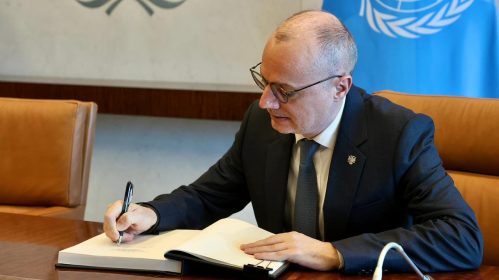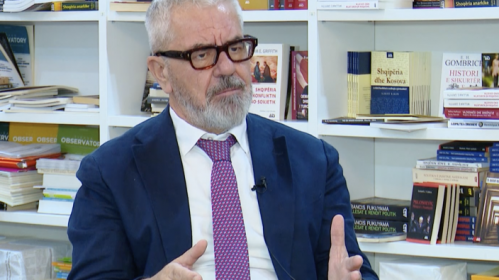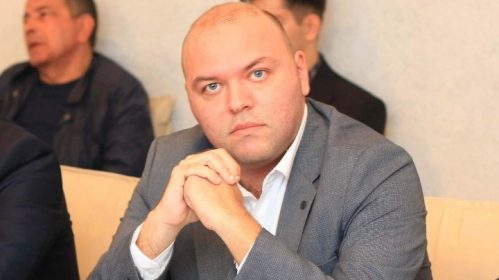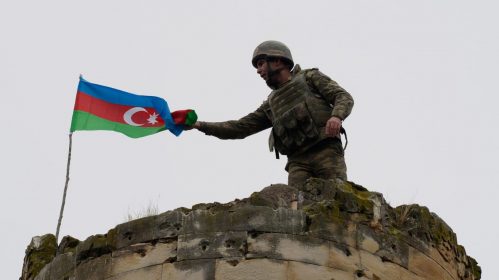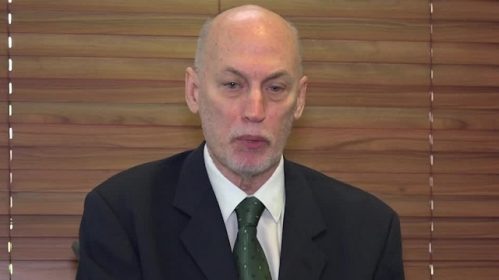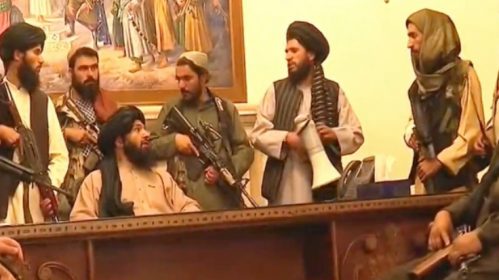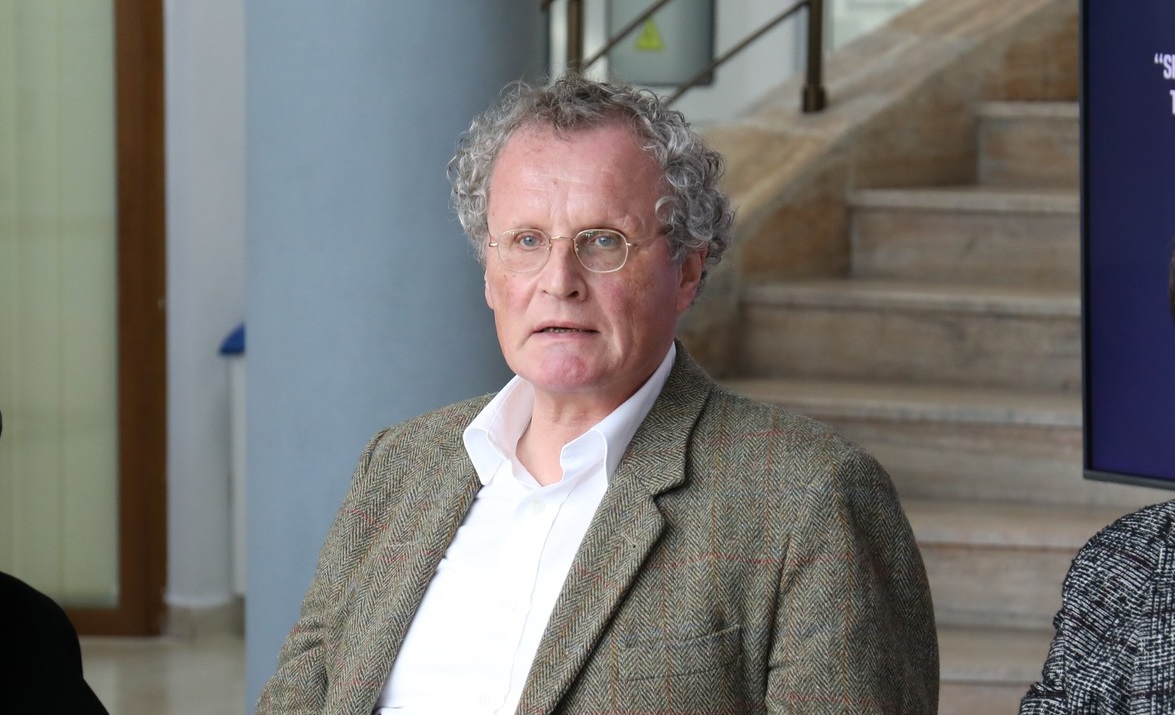
Bernd Borchardt: Protection for Jews and Persecution of Jews in the Albanian-speaking Area during World War 2
Bernd Borchardt is a retired German diplomat, including as German Ambassador to Albania 2007-10, Head of the EULEX Mission in Kosovo

By Bernd Borchardt
The Jewish population and about 2000 Jewish refugees found during the Holocaust protection and support in Albania, from the Albanian population and from parts of the Albanian government. Very few Jews became victims of German persecution or the war in Albania. About 450 Jews who lived in the German-occupied Northern Kosovo or had fled there were already in 1941/42 mostly deported and murdered. The Italian occupiers of Kosovo deported 51 Jewish refugees in early 1942 to the Germans. They also were mostly murdered. After the German occupation in September 1943, German forces arrested – mainly through the Albanian SS “Skanderbeg”-Division – almost 600 Jews and deported them to concentration camps, where many were murdered. Few Jews lived In the Italian-occupied western part of today’s Republic of North Macedonia. A substantial number of Jews escaped through the region to Albania, mostly with help from the local population.

An Overview of the Current State of Research
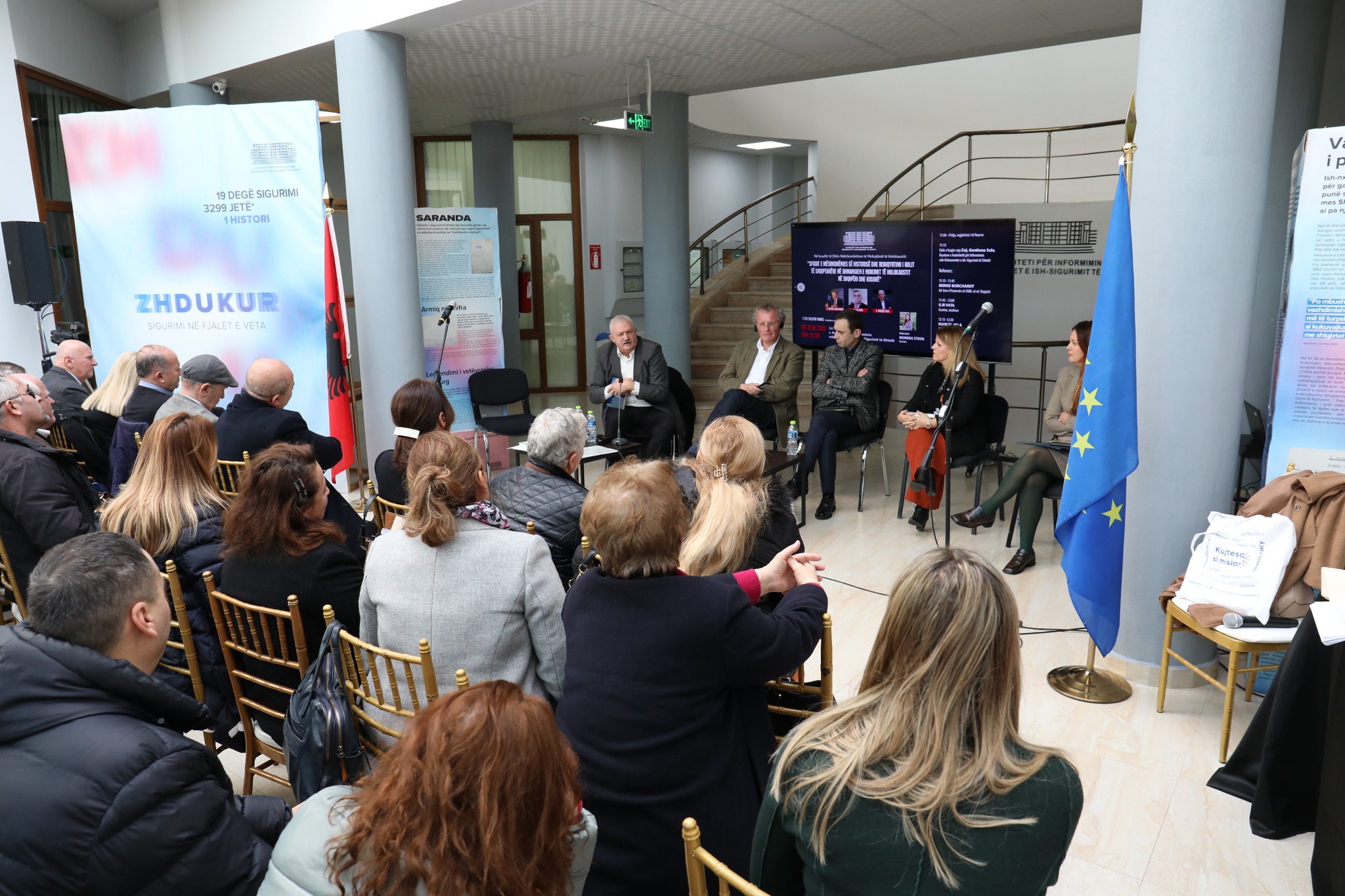
Regional Context
Large parts of the Western Balkans were characterized by brutal persecution of Jews during the occupation by Germany and some of its allies. The Jewish population and Jewish refugees living in the Bulgarian-occupied part of Northern Macedonia were almost entirely deported to extermination camps and murdered – together more than 7,000 people. The Jewish population of the German and Bulgarian occupied parts of Greece was largely murdered. After the Italian surrender in 1943 the German occupiers also deported and murdered most of the Jewish population in the previously Italian occupied part of Greece, together well over 50,000 Jewish people from Greece died. The Jewish population of German-occupied Serbia (about 13,000) was largely murdered by the German occupiers, as were about 4-6,000 Jewish refugees in Serbia. In Bosnia and Herzegovina there were about 14,000 Jewish citizens in 1941, about 10,000 were murdered in the “Independent State of Croatia”, to which Bosnia and Herzegovina mostly belonged. This also applies to the Jewish population of the Croatian core area, where large parts of the Jewish population (over 20,000) were murdered. In 1941, the Jewish community in Montenegro comprised only about 30 people. Several hundred Jewish refugees escaped to Italian-occupied Montenegro. Almost 200 refugees were deported to Italy via Albania after an uprising in Montenegro in 1941, most of them survived. In 1943/44, the German occupiers deported 28 Montenegrin Jews and a larger number of refugee Jews from Montenegro to concentration camps in Belgrade and Germany, where most of them were murdered. Some Jewish refugees managed to hide in Montenegro until the end of the German occupation.
Albania (occupied by Italy in 1939), Kosovo, parts of northern Macedonia, Montenegro, parts of Greece and parts of the Dalmatian coast were occupied by Italy from 1941 to 1943. Italy’s policy toward Jews until 1943 was one of discrimination, exploitation, and social exclusion, but the regime did not resort to mass murder. After Italy entered the war, foreign Jews in particular were interned and in several cases extradited to German death camps or refused entry to Italian occupied territory. This policy also largely determined (see below for Kosovo) Italy’s actions in the occupied territories until 1943.
Overview
The Jewish population and a much larger number of Jewish refugees found protection and support by the local population and parts of the government in Albania, no one was extradited to the German killing machine, very few Jews became victims of German persecution or the war in Albania. While there are reports about the help of individuals in Kosovo for their Jewish co-citizens and for refugees, most of the Jews in Kosovo were arrested and deported. In the Italian-occupied part of Kosovo (1941-43), a deportation of 51 Jewish refugees to a concentration camp in Serbia, where they were murdered, is documented. After the arrival of German forces most Jews in Kosovo were arrested – mostly through the Albanian SS “Skanderbeg”-Division – and deported to concentration camps, where many were murdered. The Italian-occupied western part of today’s Republic of North Macedonia had a very small Jewish population. The region played a role in the transit of Jewish refugees from the Bulgarian-occupied parts of northern Macedonia and from Greece to Albania and in some cases to Kosovo.
At the beginning of World War II, Albania was poorly developed in terms of infrastructure and administration. This facilitated hiding and concealment for refugees from foreign occupiers. On the other hand, Albania was sparsely populated, especially off the coast, and ethnically and linguistically largely homogeneous, so that “foreigners” could hardly go into hiding there without help or at least tolerance from the population. Protection and persecution of Jews in the Albanian-speaking region during the Holocaust are far from comprehensively researched: what, for example, prompted the Albanian government to order the deportation of a group of Jews from Kosovo to the German occupiers in Serbia in February 1942 – in contradiction to Albania’s other policies? Why was the behavior of parts of the Albanian population of Kosovo towards Jews different from that in Albania? The overall history of the Italian occupation (including the fate of the [small] Jewish population and of Jewish refugees in the area) of Western Macedonia is poorly researched.
It is hoped that researchers in Albania will find more interest in this chapter of Albanian history and will advance the research. Names of places are used as in the English language. “Albania” refers to the territory of the present-day Republic of Albania, “Kosovo” to the present-day Republic of Kosovo. “Western Macedonia” refers to the western part of the present Republic of North Macedonia occupied by Italy in 1941-44. “Greater Albania” refers to the region that existed in 1941-44, which included the above regions, as well as smaller parts of Montenegro and of Serbia (Sandžak).
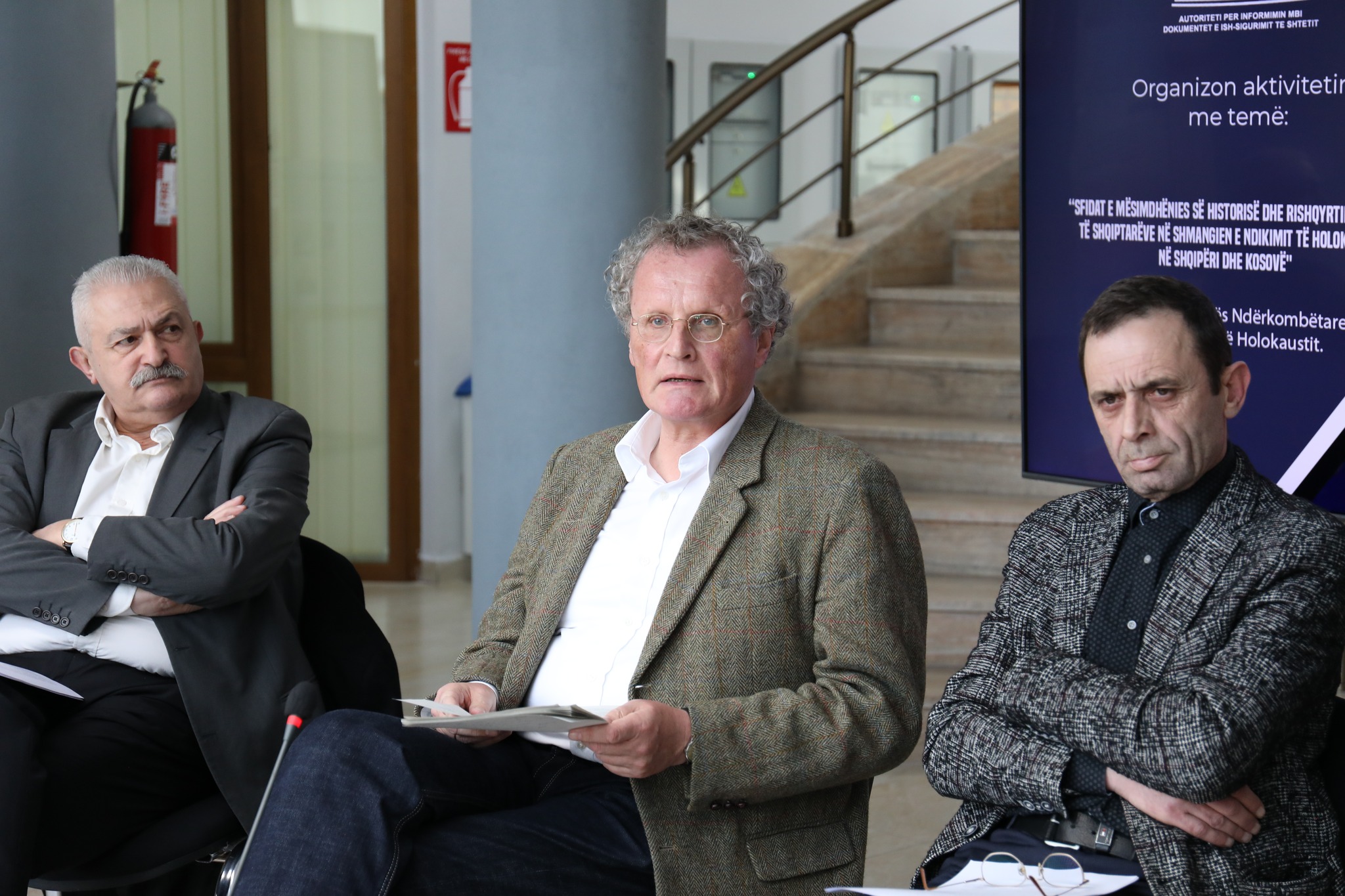
Protection for Jews in Albania
Albania did not allow persecution of Jews on its territory. Many Albanians protected their fellow Jews and Jewish refugees from German persecution at great risk to themselves. Albania was the only country occupied by the German Wehrmacht in which far more Jews lived after the war than before (about 12 times the number). In an admirable effort, almost all the Jews in Albania were saved.
The history of Albania’s Jewish population is poorly documented. A synagogue excavated in Saranda is dated to the period of about 400-600 CE. The Jewish community at that time was attributed to the Romaniote Jews, who were already living in Greece since the beginning of the millennium. The size and location of the synagogue suggest a relatively large and prosperous community. Medieval documents mention Jewish merchants in Durrës, 18th century documents in Elbasan.[1] With the expulsion of Jews from Spain in 1492 and from Portugal, immigration of Sephardic Jews followed. In the early modern period, the Jewish community in Albania was in active exchange with Romaniote communities in Greece and appears to have been relatively large. The community in Albania dwindled to about 200 people by the 1930s. A 1937 census registered 191 Jews in Albania, including one German, one British, and one Austrian, as well as some with Greek citizenship. Italian statistics from late 1938 (or early 1939) put the number of Jews in Albania at 395, including 67 Germans,[2] but also more Albanian Jews than in 1937: probably due to naturalization. The Albanian Jewish community spoke mainly Albanian or Greek.
In the 1930s, U.S. Ambassador Bernstein described Albania as a country with three dominant faiths (Orthodox, Muslim, Catholic), the only country in Europe where there was no hatred against Jews. In the same period, with the increasing oppression of Jews in Germany and with anti-Semitic laws in other countries as well, plans were developed by Jewish organizations to settle a larger number of Central European Jews in Albania. This ultimately failed due to Italian resistance, which feared for its dominant influence in Albania.
After the “Reichsprogromnacht” 1938, the Albanian King Zog became involved and, according to his son Leka, arranged for the issuance of some 400 visas for Jews from “Greater Germany” who were willing to emigrate.[3] However, there was also countervailing legislation. In September 1938, at the instigation of the Chamber of Commerce in Tirana, Albania prohibited Jews from engaging in trade and commerce by a decision of the Council of Ministers.[4] Beginning in January 1939, Albania, under pressure from Italy, introduced a regulation that Jews entering the country must show 250, and later 500, gold francs. Nevertheless, work and residence permits were issued. In total, about 800 Jewish people found refuge in Albania until the beginning of World War II.[5]
On 7 April 1939, Italy occupied Albania. King Zog fled abroad. Thereafter, Italian anti-Semitic laws were to apply in Albania as well, but in practice were hardly enforced. Albanian authorities were now under the supervision of an Italian governor-general, but entry and transit visas were still issued to Dutch, German, Yugoslav and Czechoslovak Jews in 1940. Decrees for the “repatriation” of Jewish refugees who had entered as tourists were issued several times but, according to current research, were not implemented (exception Kosovo 1942, see below). The German Consulate General was apparently promised expulsions: the German representation reported that Albania would deport 85 German Jews and enclosed a list of names among others for the Gestapo.[6] This deportation did not take place either.
In the summer of 1941, Italian authorities transported a group of about 192 mostly Bosnian and Serb Jews from Tivat in Montenegro to Kavaja in Albania. The deportation took place in connection with the deportation of Montenegrin insurgents. From here, the Jewish prisoners were transferred to the Ferramonte camp near Cozenza in southern Italy at the end of October 1941; the camp was liberated by the Allies in 1943. A small group had been transferred to northern Italy, where they fell into the hands of the German murder machinery after the Italian surrender.[7]
On 20 March 1942, the Albanian Ministry of the Interior instructed the prefectures in Kosovo and Western Macedonia to send to Albania all Jews who had lived there before the occupation of Yugoslavia.[8] Parts of the literature portray this as deportation and arrest; accounts of experiences suggest an aid measure for Jewish refugees in Kosovo, where it was more dangerous for them. Shortly thereafter, an order was issued to bring “politically endangered” Jews to Albania as well. On 5 June 1942, the Ministry of Interior also transferred Jews who had fled to Kosovo after the fall of Yugoslavia to Albania.[9] Those officially transferred to Albania were interned mainly in Kavaja, Kruja, Berat and Burrel. In parallel, a flow of refugees from Kosovo to Albania began, which was not recorded. Figures on Jews who escaped from Kosovo to Albania during this period therefore remain speculation. This also applies to the number of people who fled to Albania from the Bulgarian-occupied part of North Macedonia after 60 Jews were handed over by Bulgaria to the Gestapo in October 1941. Jewish refugees who had fled to Albania from other countries were also housed in these camps in some cases, after having lived in collective housing until then with the support of Jewish communities in Albania or Italy, among others, and in some cases were able to work – even for the Italian armed forces. In an unknown number of cases, Jewish refugees obtained Albanian citizenship and were thus able to travel to Italy.
The camps in Albania were not comparable to the concentration camps in Nazi Germany. For the most part, the inmates were able to move freely in the communities, and the government provided for them until November 1942, albeit at a low level and in the most basic conditions. After that, people had to fend for themselves. They were allowed to leave the camps, but they had to register in new places of residence, as it was suspected that Jewish refugees would support the partisans. Many refugees often tried to evade surveillance by obtaining forged documents or by going into hiding. In this they found support in the administration and from the Minister of the Interior and help from Albanian families. Also in 1942, 350 Jewish refugees from Dalmatia reached Albania.[10]
In 1943, Italian authorities increased pressure on Jewish refugees in Albania and arrested a larger group in Tirana. The Albanian Ministry of the Interior intervened and the prisoners were released.[11] The files of the Albanian State Archives contain references to arrests of Jewish “communists” or “partisans,” but their fate is not documented there. With the fall of Mussolini on 24 July 1943, Italian pressure on the Jews in Albania eased. After the capitulation of Italy and the occupation of “Greater Albania” by the German Wehrmacht in September 1943, many refugees panicked and tried to escape to villages and hide there with the help of the Albanian population.[12]
The German occupation forces initially had the political goal of treating Albania as an autonomous and independent state in which the Wehrmacht was a friendly guest. The German Foreign Office assumed that persecuting Jews in Albania was not feasible vis-à-vis the country without negative consequences for relations with its government. In a meeting on the treatment of Jews in Albania, the Gestapo (Gruppenführer Müller) then accepted the Foreign Office’s reservations about anti-Jewish measures in Albania. “An action carried out against the will or without the knowledge of the Albanian government would have a hurtful effect and cause serious complications in Albania.” The Gestapo “would therefore, in accordance with the wishes of the Foreign Office, allow measures to be taken in Albania only after they had consulted again.”[13]
This, however, did not affect Kosovo and Western Macedonia (see below). The German occupiers’ restrained policy toward Albania changed in the spring of 1944, when it became clear that no permanently German-friendly state could be established in Albania: the German military authorities demanded lists of Jews living in the country from the Albanian government, but the government did not hand over such lists. Similarly, after the Italian surrender, the head of the camp in Kavaja had already destroyed existing lists there before the Germans arrived. Already on 31 August 1943, the Albanian Minister of the Interior, Kole Mirakaj, had instructed all prefectures and police directorates to issue Albanian passports to all non-Albanian Jews.[14]
Nevertheless, the pressure of persecution increased, especially on refugee Jews living in Albania. They hid in remote villages or had to change their shelter more frequently. Some have testified to this, either in the files of Yad Vashem or as books.[15] It is known from two families living in Albania that they became victims of the Holocaust. Five members of the Arditi family were arrested in Shkodra in the fall of 1944 and deported to the Bergen-Belsen concentration camp. Only the father of the family survived, but died debilitated shortly after his liberation. Four members of a second Jewish family from Prishtina were deported from Shkodra to Bergen-Belsen, but survived. Some other Jews became victims of the war: David Kohen was shot in a mass execution in retaliation for partisan attacks, and several younger Jewish men died as partisans fighting German occupiers and their allies. Relatives of Rudy Abravanel were most likely murdered by smugglers who were to take them to Albania.[16] On 16 April 1944, German forces arrested six Jewish refugees from Kosovo in Albania.[17] They had been betrayed by a young Albanian woman who thus hoped to safe her boyfriend who had been arrested as a communist. Albanian government officials (Deputy Interior Minister Coba) called this interference in internal affairs, paid a ransom and obtained the release of these and other prisoners.[18]
The number of Jews rescued in Albania and with the help of Albanians is unclear. In 2005, the General Directorate of Albanian Archives provided the US Holocaust Memorial Museum with a list of 2,394 names, which was also published.[19] This is 12 times more Jews than lived in Albania in the 1930s. Other authors arrive at lower figures, but rely on official wartime statistics, bearing in mind that many Jews did not register officially or under a different identity in Albania. The American historian Bernd Fischer, who among other things has written a book on Albania in World War 2, assumes that there were 1,800 Jews in Albania in 1945. A curriculum prepared with the support of the embassy of Israel for Albanian schools assumes 3,750 Jews who came to Albania in the first half of the 20th century and stayed or found protection there. This is likely to include transit travelers from before the war began.[20]
The chapters on Kosovo and northern Macedonia provide an overview of refugees who managed to escape to Albania from or via these countries. In 1943, after the occupation by German troops of the parts of Greece that had been occupied by Italy until then, it is likely that quite a few northern Greek Jews also fled to Albania. The Albanian Jewish community, especially in Vlora and Gjirokaster, was largely descended from Romaniote Jews from Greece. In southern Albania, partisans played a relatively strong role in the rural areas from as early as the end of 1943, so German persecution pressure there may have been much lower.
Equally unknown is the number of residents of Albania who helped Jews survive. The list of “Righteous Among the Nations” in Albania maintained at Yad Vashem contains 75 names, with two Albanians from northern Macedonia and three Albanians from Kosovo included on this list. Norman Gershman reports in “Besa Muslims who saved Jews in World War II” (see footnote 3 above) about several other rescuers.
Persecution of Jews and Protection for Jews in Kosovo
Persecution of Jews in Kosovo
A broad majority of the Jews living in Kosovo and many Jewish refugees in Kosovo perished in the Holocaust. There was a larger Jewish community in Kosovo in 1941, largely concentrated in Prishtina. Himka and Michlic estimate about 5-600 Jewish citizens of Kosovo, of whom about 400 lived in Prishtina and a larger number in, for example, Mitrovica (113), Prizren (16), and Peja (15).[21] The community mainly descended from Sephardic Jews who had been expelled from Spain and Portugal starting in 1492 and spoke predominantly Sephardic Ladino.
In the so-called Balkan campaign, German troops attacked the kingdoms of Yugoslavia and Greece on 6 April 1941. The campaign ended with the surrender of the two countries on April 17 and 23, respectively. The Wehrmacht was supported by Hungarian, Bulgarian and Italian troops. Kosovo was divided into three occupation zones: the southeast around Kaçanik was occupied by Bulgaria, the north around Mitrovica by Germany, the rest by Italy. The present Republic of North Macedonia was divided: Italy occupied the majority Albanian-speaking areas, Bulgaria the rest of the country. Italy annexed the occupied territories to Albania, which Italy had already occupied in 1939.
Even before the war, several thousand Central European Jews fled to Yugoslavia, some of them reaching Kosovo. They came mostly from the German Reich, Austria, which was annexed by Germany in 1938, and from the parts of Czechoslovakia occupied in 1938/39. After the German conquest of Serbia, a broad flight of Serbian Jews and Jewish refugees in Serbia to or through Kosovo began. A total of about 3,000 of these refugees are believed to have reached the Italian occupied zones (in addition to Kosovo and western Macedonia, Montenegro and parts of the Dalmatian coast), and Albania.[22] Of these, several hundred appear to have fled to Kosovo (including 50 from Germany, Poland, Austria, and Czechoslovakia who had been interned by the Kingdom of Yugoslavia at Kuršumlijska Banja near the border with Kosovo). Many followed until the Italian surrender in 1943.
The Jewish population of German-occupied Mitrovica was deported and murdered early. The daily report of the 117th Jägerdivision of 19 March 1942 reports 500 Jews deported from Mitrovica to the Sajmište (German: Semlin) camp near Belgrade.[23] A rescuer of a Jewish child, Hajrija Imeri, testified after the war to the Serbian Ministry of Interior that the German persecutors were assisted by Albanian militia.[24] 88 Jewish residents of Mitrovica were deported, 75 of them died in the camp[25]; the total number of Jewish residents of the Mitrovica region at that time is given by “www.kosovoholocaust.org” as 113. The more than 400 other Jews were probably refugees, including 51 Jewish refugees from Serbia which were deported from Prishtina to Mitrovica two days earlier by the Italian Carabinieri – see below.
Wolfgang Benz also mentions this deportation of 500 Jews from Mitrovica by the German occupiers.[26] These were mostly killed in the concentration camps established in Serbia. There were still about 6,000 Jewish women and children surviving in Sajmište when they arrived. The Jewish men had mostly been killed earlier. The approximately 6,500 prisoners were suffocated in truck bodies with exhaust gases. In June 1942, the head of the security police in Serbia, Schäfer, reported to the Reich Security Main Office (Reichssicherheitshauptamt) “Serbia is free of Jews”.[27]
Compared to Serbia, Jewish population and refugees were relatively safe from extradition to the German murder machinery in the Italian-occupied part of Kosovo until 1942. On 28 February 1942, however, the Albanian Council of Ministers ordered the transfer of Jewish refugees with false papers from Serbia to the German military authorities there. On 17 March 1942, Italian Carabinieri transferred 51 Jewish refugees to the Gestapo in Mitrovica on the basis of this order. From there they were transported to the Sajmište camp near Belgrade and murdered. These people probably belonged to the group of 500 Jews deported from Mitrovica on 19 March 1942. The Italian officer in charge reported that he had invited German officials and Serbian and Albanian gendarmes to a breakfast on this occasion, which took place in a “cordial atmosphere”.[28]
No other deportations from Kosovo are mentioned in the literature for the period of the Italian occupation. The Albanian government arranged for the evacuation of 94 Jewish families and 87 individuals to Albania, in contrast to the extradition decision of February 1942. These were mainly refugees. In addition, many left Kosovo through informal channels. It is estimated that about 1,000 Jews fled Kosovo to Albania in 1942 alone. The situation of Jews living in Kosovo or who fled there deteriorated significantly with the surrender of Italy and the occupation of the previously Italian-occupied territories by the German Wehrmacht.
In addition to help from citizens of Kosovo (see below), they were also subjected to attacks by the local population there.[29] Since the Jewish refugees in Albania now feared persecution by the German occupiers in Albania as well, many who had previously fled from Kosovo to Albania returned to Prishtina and Prizren. Here, however, they were exposed to German grip differently than in Albania, since the German leadership wanted to define Albania itself as a neutral country, protected by German forces against communist partisans or other opponents, but not an ally in the war. This consideration did not extend to Kosovo. An important instrument of persecution of Jews in Kosovo became an SS division established there, the 21st Waffen Mountain Division of the SS “Skanderbeg” (see note, below). The daily report of the Military Commander Southeast of 16 April 1944 records that the SS Division “Skanderbeg” arrested 300 Jews in Pristina. Wehrmacht officers confirmed the arrests at the Nuremberg Hostage Trial in 1947[30] The “Skanderbeg” Division was still in its formation phase at this time. However, an Albanian battalion, previously part of the “Muslim” 13th Waffen SS Division “Handschar,” had already been trained and deployed to Kosovo as core of the “Skanderbeg” Division.
For these prisoners, a concentration camp was set up in Prishtina in the early summer of 1944, guarded by the Albanian battalions of the “Handschar”-SS-Division (and now a nucleus of the “Skanderbeg”-SS-Division) that was considered particularly reliable. Besides Jews, communists, partisans and others were held there. The “Skanderbeg” Division was again used in the persecution of the Jews from 28 May to 5 June 1944. Its commander Schmidhuber reported that the division had arrested all 281 Jews in Kosovo, as well as 210 communist officials.[31] A deportation list from Belgrade to Bergen-Belsen dated 23 June 1944 lists 437 names, including 351 with birthplaces in Kosovo.[32] The Bergen-Belsen memorial book, which contains names of about 50,000 of the 120,000 prisoners of the concentration camp, lists 264 Jews from Prishtina from this transport, another 14 Jewish names from this transport do not appear in the memorial book. According to the memorial book, 92 of the 264 Jewish prisoners died.[33]
The Albanian National Archive holds a list of the “4th deportation to the Reich”, on which 34 people are referred to as “Jews”, eight others as related to them. Other deportees on the list are mostly referred to as “communist” or “partisan” or similar. Prof. Dr. Shaban Sinani published this list.[34] Lists of the 1st, 2nd and 3rd deportation do not seem to exist in archives. Other authors come to similar conclusions,[35] obviously not taking into account the number of victims from German-occupied Mitrovica. Rebeka-Beka Hara was among the survivors of the group of 300 people arrested in April 1944.[36] She was deported with others to Bergen-Belsen via Sajmište in mid-May 1944. She reports being plundered by Albanian soldiers in SS uniform. She does not appear on the list published by Sinani, by Bergen-Belsen Concentration Camp as a memorial book, nor on lists published by Yad Vashem, and survived deportation to Bergen-Belsen, where her family perished. Before the arrest, she had been able to hide together with the family for a long period of time in Prizren and in Albania.
In the database of Yad Vashem there is another list of 15 deportees from Prizren. Six were murdered, five survived the Holocaust, the fate of four persons is unknown. The same database states that 190 members of the Jewish community of Prishtina were murdered. The database of the US Holocaust Memorial Museum counts 302 victims of the Holocaust from Prishtina, few of whom survived. In summary, according to Italian and German documents, more than 1,000 Jews were arrested on the territory of today’s Republic of Kosovo. Further documents prove the deportation of about 800 Jewish people to Sajmište (including most probably the 51 Jews deported from Prishtina to Mitrovica) and partly from there to Bergen-Belsen. 92 died in Bergen-Belsen, The Serbian Secretariat for Internal Affairs in Prishtina assumed in 1960 that there were 206 Jewish survivors coming from Kosovo.
Note on the “Skanderbeg” Division
The 21st Waffen Mountain Division of the SS “Skanderbeg” (Albanian No. 1) was a division led by mostly German Waffen SS officers, recruited in 1944 mainly in Kosovo. It had already been preceded by the formation of so-called Albanian “self-defense units” such as the “Albanian-Muslim SS Volunteer Legion” since the fall of 1943 in Sandžak and northern Kosovo, and by the establishment of an Albanian battalion of the 13th Waffen Mountain Division of the SS “Handschar” from April to fall 1943 in the same region. The bulk of the “Handschar” Division consisted of Bosnian Muslims. Recruitment was not extended to Albania, which was Italian-occupied until the Italian surrender (8 September 1943). After the German occupation of Albania in September 1943, Germany tried to present Albania as a neutral country that was only temporarily protected by German forces.[37] Recruitment efforts attempted to appeal to an alleged proximity of Islam and National Socialism and profiled the “Handschar” division as a Muslim unit. German sources indicate that an important reason for Albanian recruits to enlist was access to weapons and training after Serbian and Montenegrin partisans repeatedly attacked and murdered Albanians in their regions.[38]
When the “Handschar” Division completed its training in France and the German Reich in March 1944, the unit was transferred to Bosnia. The Albanian battalion was detached from the unit and transferred to Kosovo. Here it was to support the buildup of the “Skanderbeg” Division. In the spring of 1944, the SS had begun recruiting soldiers for the “Skanderbeg” Division. German regular personnel were withdrawn from other SS divisions in the region, as well as about 300 men from the aforementioned “Handschar” battalion. Recruitment was largely limited to the Prishtina/Prizren/Peja triangle. Franziska A. Zuegg mentions in her monograph on the division that recruitment for the “Skanderbeg” division was based on a wide variety of motivations: Forced recruitment, social pressure within clan structures, cooperation with Germans perceived as liberators from Serbian occupation, prevention of rule by communists or Serbs loyal to the king, fear of losing Kosovo’s status as part of Greater Albania, protection for Albanians against escalating interethnic violence in many border areas of Kosovo and the western part of today’s Republic of Northern Macedonia, which was also occupied by Italy.[39]
Significant sections of the government in Tirana had an interest in the formation and training of the division: it was to become the nucleus of an Albanian army after the withdrawal of the Wehrmacht, fighting both communist partisans and neighbors with territorial ambitions in Albania. The leader of the 2nd League of Prizren, Bedri Pejani, managed to get Albania to consider service in the division as regular military service.[40] Ultimately, the division was also recruited from released Albanian prisoners of war from Yugoslav units who had been in German prison camps since 1941 or who had performed forced labor. The numbers of released prisoners vary between 4,000 and 20,000, of which only a small part joined the Skanderbeg Division.
Protection for Jews in Kosovo
The Italian deportations from Kosovo in 1942 prompted many citizens in Kosovo, as well as the Albanian leadership, to take countermeasures. Dr. Spiro Lito, an Albanian physician, prevented the deportation of more Jewish internees to the German area by declaring the group infectious and helping them escape to Albania and hiding them there.[41] The Albanian government intervened against further deportations. On 30 March 1942, the Ministry of Interior demanded that Jews who had come to Kosovo before the beginning of the Yugoslav war in 1941 be brought immediately to Berat in Albania.[42] About 250 Jews were then transported to camps in Albania.[43] It is believed in the literature that protests by Italian Jewish organizations and Jewish Albanians led to this change in policy by the Albanian government.
Shela Alteraz, a Jewish woman from Štip/North Macedonia, tells in the film “Take the Girl” about her escape from the Bulgarian occupiers who had rounded up the Jewish population of the Bulgarian-occupied part of North Macedonia in March 1943 and handed them over to the German Reich to be murdered in Treblinka.[44] She was able to stay hidden in Kosovo for a long time with the help of Albanian villagers and survived the Holocaust.
Yad Vashem counts seven people from Kosovo among the “Righteous Among the Nations”: Aslan Mustafa Rezniqi from Dečani, Faik and Sabrije Sharri, Pero Jovanović, Ljudica Mandišić and Jelica Ranković from Prizren and Imeri Hajrija from Mitrovica. Norman H. Gershman reports nine Kosovo Albanian families who protected Jews, including the Rezniqi family mentioned above.[45] Shaul Gattenyo was saved from the Bulgarian-German deportations to Treblinka as a child by one of his parents’ employees in Skopje and survived along with other Jewish children with the nuns of the Letnica monastery in Kosovo.[46] In this book, Sevdail Demiri tells the story of Veli Meliqi, who helped 16-17 Jewish refugees from Macedonia in the Kaçanik area to escape to Albania (p. 379ff).
Protection for Jews and Persecution of Jews in Western Macedonia
The Jewish community in what is now North Macedonia has its roots in antiquity. First Jewish settlers are said to have come to the region after the conquest of Jerusalem by Alexander the Great. A synagogue was found in the excavated ancient city of Stobi. The community grew primarily due to the arrival of Sephardic Jews after the expulsion of the Jewish population from Spain and Portugal beginning in 1492. The community largely spoke Sephardic Ladino. It was concentrated mainly in Skopje, Bitola/Manastir and Štip.
After the defeat of Yugoslavia in 1941, in addition to the mass of Kosovo, the west of what is now the Republic of North Macedonia became part of the Italian occupation zone and annexed to Albania. These were the regions around the towns of Tetovo, Debar, Struga, Gostivar and Kičevo.
There was no Jewish community there, according to information given to the author by the Holocaust Memorial Center in Skopje. Sarfatti mentions 17 Jews in Tetovo.[47] The 1931 census in the Kingdom of Yugoslavia records 35 people of “other beliefs” which were usually Jews in the later Italian-occupied areas of Macedonia. The existence of Jewish residents of the region is confirmed by Benz. After the mass arrests of over 7,000 Jews in the Bulgarian occupied zone, just under 200 were released, including 19 people with Albanian citizenship, which included residents of the Italian occupied zone in Macedonia.[48] A deportation list of the SS division “Skanderbeg” lists a deported Jewish family from Tetovo (3 people) and a family from Gostivar (6 people) (see note 35 above).
Already during the first days of the occupation of Macedonia by Bulgarian forces in April 1941, about 300 Jews escaped from Serbia to Macedonia.[49] It is difficult to estimate how many Jews in total had fled to Macedonia by the time of the mass deportation of the Jewish population by Bulgarian security forces in March 1943. The United States Holocaust Memorial Museum mentions in its victims database four Jews who hid in the Tetovo region (Herman Švarc and Jakov Bencion from Belgrade, Haim Mejuhas from Vienna and Zivadin Belunovich, who was born in Tetovo. Asan Asanoski is mentioned in connection with Struga in the database, Anton Cadiković from Debar and Vladimir Sterjović from Kičevo). Mufail Bicaku and his son Niazi belong to the “Righteous among the Nations”. They hid several Jewish families with 26 members in the Struga region.[50] In addition, the region was an important transit route for many Jews who wanted to flee to Albania. Irene Grünbaum describes how residents of Turkish and Albanian identity in the region helped her escape Bulgarian arrest and deportation in Skopje and Tetovo.[51] She received false papers in Tetovo, and the existence of a forgery workshop in Tetovo is also mentioned in German archives.
How many Jewish people escaped to Albania via Western Macedonia is unclear. Estimates speak of 1,000-2,000. Davide Rodogno[52] reports German sources (without naming them) who assumed that Jewish organizations smuggled about 1,000 Jews to Albania via Macedonia (this probably also covers refugees from Greece, some of whom are mentioned by Matkovski).[53]
The 1931 census gave the Jewish population of Macedonia as 7,762 persons. To this was added the number of the above-mentioned 300 refugees, 60 of whom were handed over to the Gestapo as early as October 1941.[54] Ristović concludes that about 600 Jews from Serbia reached North Macedonia. According to Ristović, the deportations in October 1941 triggered a first flight movement to Albania. On March 11, 1943, Bulgarian security forces deported 7,315 Jews to a camp in Skopje, 166 were released or escaped, 7,148 were deported to Treblinka and murdered there. The rest of about 600 Macedonian Jews and a few hundred refugees may have emigrated before, fled to the Italian-occupied part of Greece, to Albania, were hidden in Macedonia or joined the partisans. It is known that the relatively large Jewish communities in Monastir/Bitola and in Skopje were warned about the deportations.[55] So there was a certain chance to escape – how many were able to use this chance seems to be unclear.
[1] Harvey Sarner, Rescue in Albania, Cathedral City, California, 1997, pp. 9, 16.
[2] Laura Brazzo / Michele Sarfatti, Gli Ebrei in Albania sotto il fascismo, Milano 2010, p. 57 f.
[3] Norman H. Gershman, Besa – Muslims who Saved Jews in World War II, New York, 2008, p. 98 ff.
[4] Albanian National Archive (AQSH) 152/1938/164/22.
[5] Shaban Sinani, Hebrenjte ne Shqiperi, Tirana 2009, p. 32.
[6] Archive Auswärtiges Amt PAAA RZ214 099595 128.
[7] Laura Brazzo / Michele Sarfatti, op. cit., pp. 153-167.
[8] AQSH 152/1942/319/29.
[9] Sarner, op. cit., p. 38.
[10] Shaban Sinani, Albanians and Jews: The Protection and Salvation, Tirana 2014, p. 416.
[11] Tommaso Dell’Era, The Italian Occupation of Albania: Fascist Albania and the Persecution of Jews (1939-43), in: Giovanni Orsina / Andrea Ungari, The Jewish Question in the Territories Occupied by the Italians 1939-43, 2017, p. 327.
[12] Irene Grünbaum, Escape through the Balkans, Lincoln 1966, S.58
[13] Protocol of a meeeting between LR von Thadden/Gruppenführer Müller, 17-10-1943, Akten zur deutschen Auswärtigen Politik; Serie E, Bd. VII, Nr.54.
[14] Published in ALBINFO.CH, 20.09.2021.
[15] E.g. Johanna Neumann, Escape to Albania, London 2015 or Irene Grünbaum, Escape through the Balkans, University of Nebraska Press 1996.
[16] Yad Vashem M 31/5666, M 31/5370; Dr. Iael Nidam-Orvieto / Irena Steinfeldt, The Rescue of Jews in Albania through the Perspective of the Yad Vashem Files of the Righteous Among the Nations.
[17] AQSH 153/1944/215/44-46.
[18] www.memorie.al – Unknown documents/When Qazim Mulleti and other “collaborators” defended the Jews.
[19] Guidebook, A Reference to Records about Jews in Albania before, during and after the 2nd World War, Tirana 2006.
[20] Curriculum “Roli qe luajti Shqiperia ne shpetimin e hebrenjve gjate Holokaustit (Shoah)”, 2021, S.19.
[21] Jean-Paul Himka / Johanna Beata Michlic, Bringing the Dark Past to Light: The Reception of the Holocaust in Postcommunist Europe, University of Nebraska 2013.
[22] Olga Manojlović Pintar, Escaping, Surviving and Telling the Truth about the Holocaust in The Jewish Question in Italian occupied Territories, 2019, p. 271ff.
[23] Wehrmacht/Tagesmeldung (daily report), in: Bundesarchiv BArch RH26-117/4.
[24] www.kosovoholocaust.org, “we survived”
[25] List of names in Pavle Dzeletovic, Jews from Kosovo and Metohija, available in www.kosovoholocaust.org
[26] Wolfgang Benz / Juliane Wetzel (Eds.), in: Solidarität und Hilfe für Juden in der NS-Zeit, Regionalstudien Band 3, Berlin 2004, p. 45.
[27] Walter Manoschek, „Serbien ist judenfrei“ – Militärische Besatzungspolitik und Judenvernichtung in Serbien 1941/42, München 1995, p. 184.
[28] Wolfgang Benz / Juliane Wetzel, op. cit., Regionalstudien Band 4, 2004, p. 257; United States Holocaust Memorial Museum, Encyclopedia of Camps and Ghettos, Vol.III, p. 495ff with several references to Albanian and Italian archives, including the ordinance of the Albanian Council of Ministers mentioned above AQSH 235/1942/35/146.
[29] Wolfgang Benz / Juliane Wetzel, op. cit., Regionalstudien Band 3, Berlin 2004, p. 149.
[30] BArch RW 40/88, 16.4.1944; www.nuremberg.law.harvard.edu NOKW-668.
[31] Zusammenfassender Bericht über die Aufstellung und den Zustand der 21. Waffen-Gebirgs-Division der SS Skanderbeg, 2.10.1944, BArch RS 3-21/1 p. 4; Report des XXI. Gebirgskorps 13.Juli 1944, BArch RH 24-21/105 und 106.
[32] Yad Vashem Document Files, List of Jews who were deported to Bergen-Belsen and perished in Bergen Belsen or other camps during 1944-45.
[33] Gedenkbuch Bergen-Belsen, 2005, 2 Bände, in alphabetical order.
[34] AQSH 153/1944/172/009, 018, 020, 023, 025, 031, Shaban Sinani „Albanians and Jews, op. cit., p. 191 ff.
[35] Bernd Fischer, Albania at War, London 1999, p. 187 writes that 281 Jews were deported by the division; Michael Schmidt-Neke, Hilfe und Solidarität mit verfolgten Juden in Albanien im Zweiten Weltkrieg, in: Johanna Jutta Neumann, Umweg über Albanien, Bochum 2003, p. 144; Wolfgang Benz / Juliane Wetzel, op. cit., Regionalstudien Band 4, p. 158 also refers to the arrest and deportation of 281 Jews from Kosovo; Albert Ramaj, Bedrängte Juden im Kosovo im Zweiten Weltkrieg, in Glaube in der 2. Welt 2/2007, p. 20-21 writes about the deportation of 400 Jews by the “Skanderbeg” Division.
[36] Witness statement in www.kosovoholocaust.org – „we survived“.
[37] Hermann Neubauer, Sonderauftrag Südost, Göttingen 1956, p. 115f.
[38] Franziska A. Zuegg, Albanische Muslime in der Waffen-SS, Paderborn 2016, p. 199ff.
[39] Zuegg, op. cit., p. 221.
[40] Report of the Dienststelle des Auswärtigen Amtes (AA) beim Militärbefehlshaber Serbien to the Auswärtiges Amt, 12.4.1943 and 18.5.1944, Politisches Archiv PAAA R100998.
[41] Martin Gilbert, The Righteous: The Unsung Heroes of the Holocaust, p. 241.
[42] AQSH 154/1942/165/3.
[43] John-Paul Himka / Johanna Beata Michlic, op. cit.
[44] Youtube, Yad Vashem Survivor Testimony Films Series.
[45] Norman H. Gershman, Besa – Muslims who Saved Jews in World War II, New York 2008, p. 98 ff.
[46] Skender Asani / Albert Ramaj, Rrugetimi, Skopje 2017, p. 137.
[47] Michele Sarfatti, Tra uccisione e protezione – I refugiati ebrei in Kosovo nel marzo 1942 e le autorita tedesche, italiane e albanesi, in: La Rassegna Mensile di Israel, vol. LXXVII, p. 223ff.
[48] Wolfgang Benz / Juliane Wetzel, op. cit., Regionalstudien Band 4: Bulgarien, p. 83.
[49] Institute for Social Sciences and Humanities in Skopje, The Jews of Macedonia and the Holocaust, Euro Balkan Press 2011, p. 6.
[50] Yitzchak Keren, Rescue of Sephardic Jews by Muslims in the Holocaust, in: Journal of Sephardic Studies 2, p. 46, www.academia.eu
[51] Irene Grünbaum, op. cit., (see note 15).
[52] Davide Rodogne, Fascism’s European Empire, Cambridge 2006, p. 382.
[53] Alexander Matkovski, A History of Jews in Macedonia, Skopje 1982, p. 188ff.
[54]Milan Ristović, Jews in Serbia during World War II, p. 26, www.academia.edu
[55] Sofija Grandakovska, The Jews of Macedonia and the Holocaust, Skopje 2011, pp. 409, 411.





